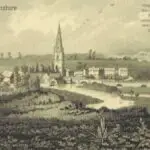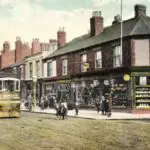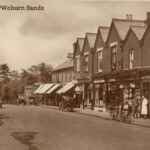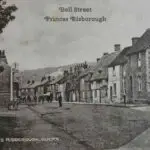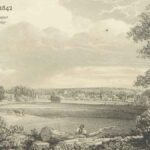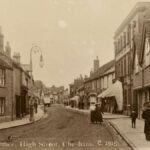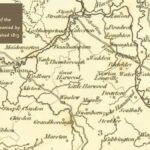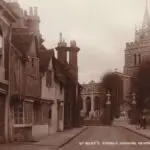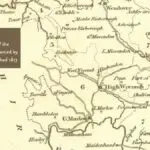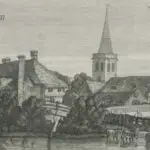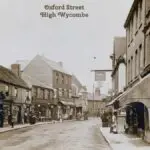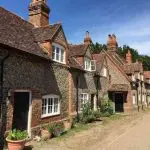Glimpse history through old images of Chesham, Buckinghamshire, England.
The Swan 1936
The Watson family welcomed a domesticated swan, called Shiela, into their home.
Swan-Derful! (1936) – British Pathé on YouTube
Turkeys 1951
A quirky newsreel about a local turkey farm – no buildings or people included.
Turkey Trouble (1951) – British Pathé on YouTube
Nye Bevan’s Farmhouse 1960
A newsreel about the death of Nye Bevam includes a glimpse of his Chesham farmhouse on the day he hosted Indian Prime Minister Jawaharial Nehru and his sister Mrs Pandit there.
Bevan – In Memoriam (1960) – British Pathé on YouTube
Safety Testing 1962
Chesham – For Safety In Planes Aka Aircraft Seat Testing (1962) – British Pathé on YouTube
A Bit of Chesham History
Extract from: History and Topography of Buckinghamshire Comprising a General Survey of the County, Preceded by an Epitome of the Early History of Great Britain, by James Joseph Sheahan
Published in 1862
Pages 838 – 840
THE town and parish of Chesham, with its several hamlets, extend over an area of 12,657 acres, and contains 5,985 souls. Its rateable value is £ 20,137.
The place derives its name from the small river Chess, which has its source here.
Chesham is a small market town situated 3 miles N. from Amersham, 13 miles S.E. from Aylesbury, 14 miles N.W. from Uxbridge, and 28 miles N.W. from London.
The town is improving, and the country around is beautifully diversified and very picturesque.
The soil on the high lands abounds with flint and chalk, in the valleys it is more alluvial.
Cestreham was one of the estates of the Bishop of Bayeaux when Domesday Book was compiled. After the attainder of John, Earl of Oxford, in 1472, Chesham was granted to Richard, Duke of Gloucester.
About 1550, it was in the hands of the Seymours; and was afterwards the property of the family of Sandys. It subsequently passed by purchase to the Cavendishes. The estate, consisting of two or three manors, now belongs to the Right Hon. Charles Compton Cavendish, the first Baron Chesham – created in 1858. This nobleman is the youngest son of the Earl of Burlington.
The Manor of Chesham Woburn is the property of B. Fuller, Esq., of Hyde House; and the Manor of Grove, and that of Hundridge belong to William Lowndes, Esq. of The Bury. Mr. Lowndes is a claimant for the Peerage of Monthermer ( See page 763 ). John Garratt, Esq., the Rev. A. H. Jeffreys, Sir James F. Doughty – Tichborn, Bart., and the family of the late R. Hemming, Esq., are also considerable land owners here.
The Town, which consists chiefly of three streets, is situated in a pleasant and fertile valley, and was formerly noted for its extensive manufacture of wooden – ware and turnery.
A considerable trade in shoe – making for the London and foreign markets is now carried on.
The Market for corn, cattle, & c., is held on Wednesdays; and there are Fairs for cattle and sheep on the 21st of April, 22nd of July, and 28th of September.
The Town Hall was partly rebuilt by Lord Chesham in 1856. Petty Sessions are held in it on the first and third Wednesday in every month.
The Gas Works were erected in 1847.
The Savings Bank was established in 1854.
The Mechanics ‘ Institute was founded in 1851, and is held in the town – hall.
The library contains about 400 volumes.
The Young Men’s Christian Association was instituted in 1854.
The Temperance Hall was built for the Temperance Society in 1852; and a Police Station is about to be erected.
The Cemetery was opened in 1858, and consists of six acres, equally apportioned to the church people and dissenters. The grounds are tastily laid out. The total cost of the cemetery, including the erection of two neat Chapels, is about £ 4,500.
The Vicarage is in the patronage of the Duke of Bedford, and incumbency of the Rev. Adolphus Frederick Aylward. Its annual gross value is £ 550, for which sum the small titles were commuted in 1843. The rectorial tithes were commuted for £ 2,326. The great tithes were formerly divided between the Abbeys of Leicester and Woburn, each of which appointed a Vicar; but the two medieties of the Vicarage were consolidated by Act of Parliament in 1767.
The Duke of Bedford being the patron of both, built the present Vicarage House, and pulled down the two houses which had belonged to the portionists.
The Church ( St. Mary ) is a venerable cruciform structure of the 14th century, beautifully situated on a slight eminence. Its component parts are a chancel, a clerestoried nave, side aisles, transepts, south porch, and central square tower. The general style is Perpendicular. The tower is surmounted with a small spire partly built of timber, and contains a clock and seven bells. The windows are uniform in shape; the east and west ones being of five lights, those in the ends of the transepts of four, and the remainder of three lights each. The porch has a parvise, reached by a semi – octagonal stair – turret in one of the angles. Each arcade of the nave consists of five arches with plain octagon columns; but the aspect of the church is destroyed by cumbrous galleries.
The organ was erected in 1852, at a cost of £ 300, raised by subscription.
The roofs are concealed by plain ceilings. The north transept is enclosed as a vestry; and the south one was formerly the burial place of the Cavendishes. The east window of the chancel was filled with stained glass in 1857 (together with a small one on the south side) at the cost of William Lowndes, Esq.
The former represents the Crucifixion, Resurrection, and other passages in Our Saviour’s life. Another window was glazed with stained glass in 1856, at the expense of the Misses Newton, as a memorial to their brother who died at Scutari.
In the chancel are several monuments of the Skottowes. One of elegant design by Bacon is to Nicholas Skottowe, Esq., who died in 1798; and another to John Skottowe, Esq., who was for many years Governor of St. Helena, and died in 1786.
On the north side is a bust of the Rev. Richard Woodcock, a former Vicar, who died in 1623.
In the south transept is a monument to Sir John Cavendish, who died in 1618. This consists of an altar tomb supporting a lofty pyramid. There is also in this transept a memorial of Mary, wife of Sir Francis Whichcote, Bart. The church likewise contains memorials of members of the Boyle, Lowndes, Ward, Carter, Nash, Beale, Arundell, & c., families.
We learn from the Records of Bucks, ( vol. ii., p. 136 ), that as workmen were employed repairing the main path from the Vicarage to the church, they discovered a brick vault in which were eight coffins much decayed. Of five of them no inscription could be deciphered; the other three which were of a much later date, were the coffins of W. West, Esq., who died in 1721; Miss Johanna West, who died in 1746; and of Richard West, who departed in 1752.
The Vicarage House, near the church is a good square building of brick.
The General Baptist Chapel, erected in 1712, and enlarged in 1735 and in 1835, is a good plain brick edifice. In 1719, Mrs. Johanna Neal left a certain sum, which was invested in land, and yields upwards of £ 100 per annum. One – half of this sum is applied to the support of the chapel, and the other moiety to the Baptist Chapel of Berkampstead. The present pastor is the Rev. Isaac Preston.
The Particular Baptist Chapel was erected in 1719, and enlarged in 1814; and is a plain brick building. This mission is endowed with land let for £ 7 108. a – year. The Rev. Wm. Payne is the minister.
The High Calvinistic Chapel was erected in 1820, at a cost of £ 800.
The Independent Chapel was built in 1724. This has a small endowment.
The Friends ‘ Meeting House was rebuilt in 1796, but is now seldom used, there being but one member of the Society of Friends ‘ in Chesham.
The National School was built in 1845, and is a neat substantial structure of brick. About 130 children attend.
The Infant School, built in 1851, is attended by about 100.
The British School for boys was built in 1828, and is endowed with £ 10 a – year. About 60 boys attend.
A Girls ‘ School on the British and Foreign system was established in 1852; and about 50 attend it.
There are Almshouses ” for four poor godly people, ” founded by Mr. Thomas Weedon, and endowed by him with lands which let for £ 105 per annum.
A spot is still shewn near the north end of the town, where, in 1532, Thomas Harding was burnt at the stake for holding Protestant opinions. An account of this event is given in Fox’s “Acts and Monuments.”
The seats in the parish are Latimer House, the splendid mansion of Lord Chesham; The Bury, the seat of William Lowndes, Esq.; and Hyde House, the seat of Benjamin Fuller, Esq.
More about Buckinghamshire
- Old Images of Buckinghamshire, England
- Old Images of Wolverton, Buckinghamshire
- Old Images of Woburn Sands, Buckinghamshire
- Old Images of Princes Risborough, Buckinghamshire
- Old Images of Olney, Buckinghamshire
- Old Images of Newport Pagnell, Buckinghamshire
- Old Images of Chesham, Buckinghamshire
- Old Images of Bletchley, Buckinghamshire
- Old Images of Aylesbury, Buckinghamshire
- Old Images of Amersham, Buckinghamshire
- Milton Keynes: Old Photos & Film
- Old Images of Beaconsfield, Buckinghamshire
- Old Images of Marlow, Buckinghamshire
- High Wycombe History: Old Photos & Film
- Buckinghamshire, England: Local History Resources


